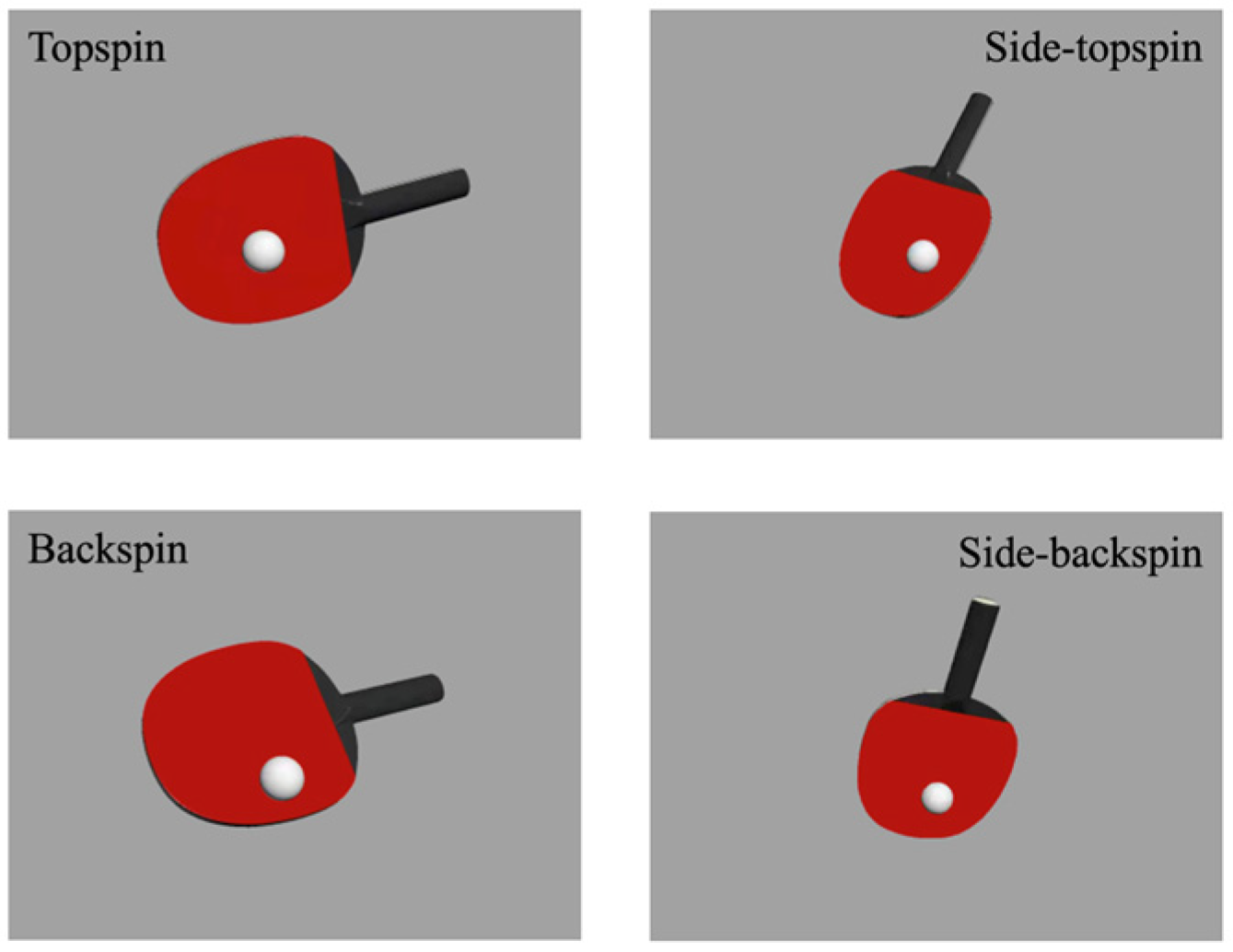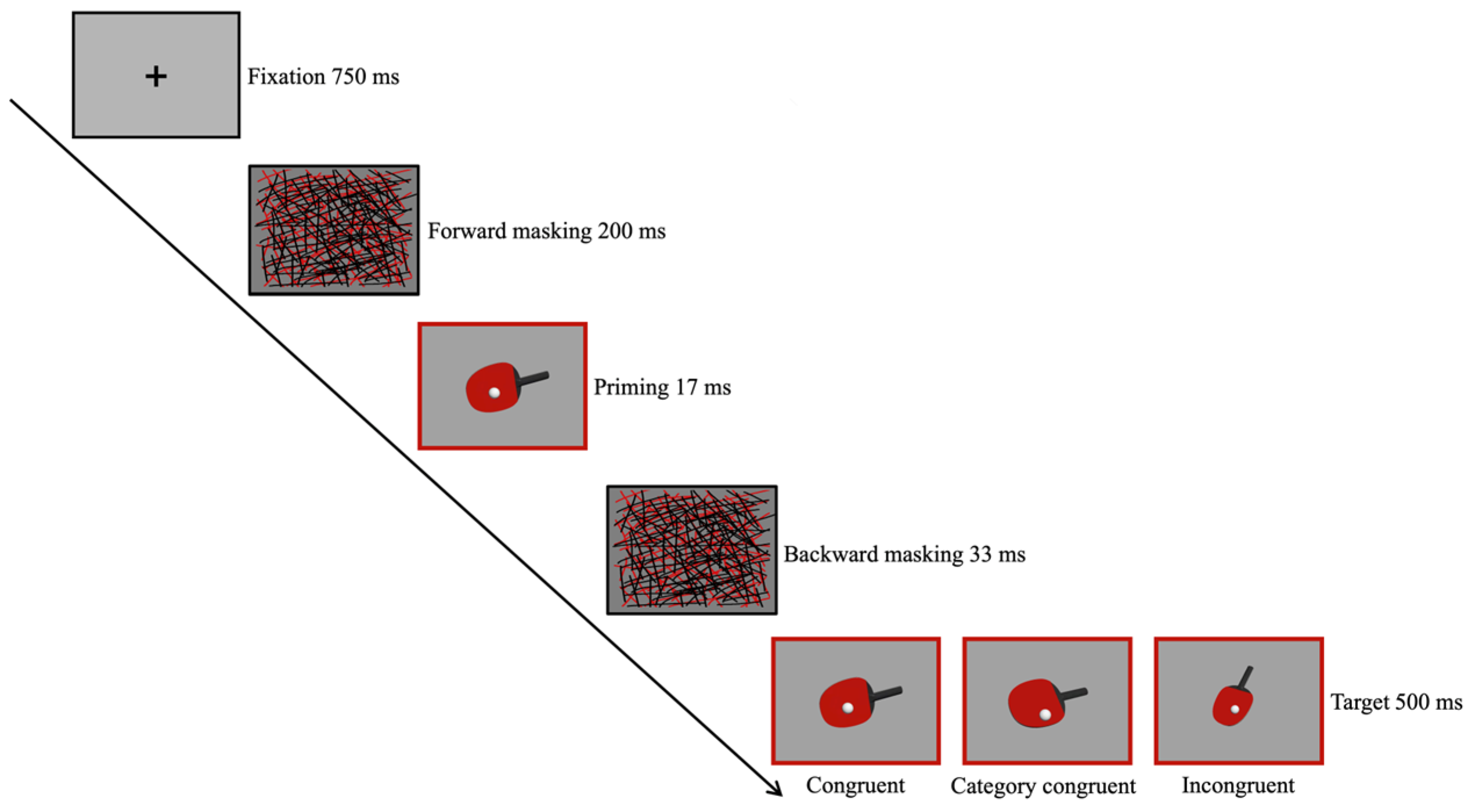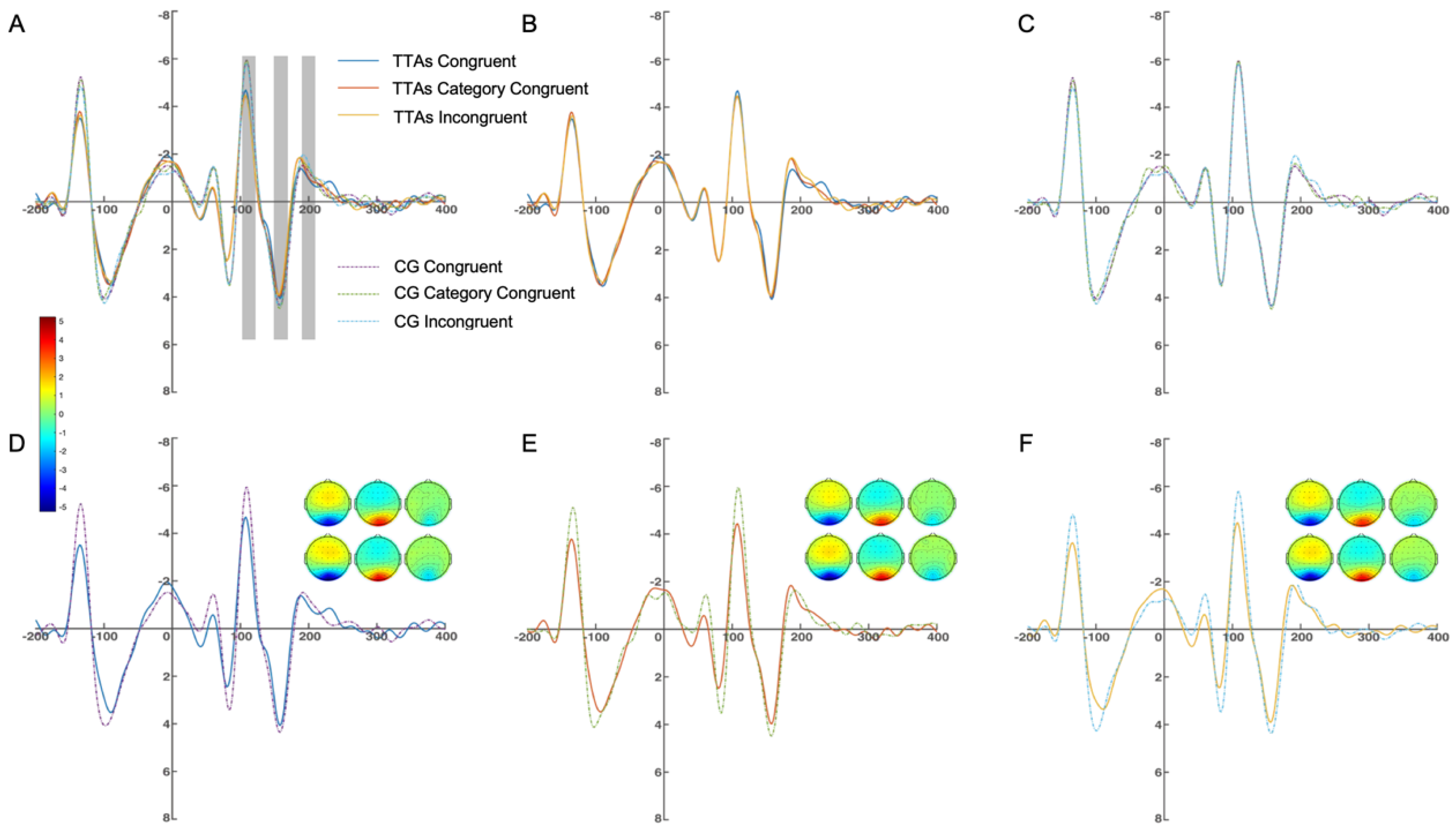High Neural Efficiency in Unconscious Perceptual Processing among Table Tennis Athletes: An Event-Related Potential Study
Abstract
1. Introduction
2. Materials and Methods
2.1. Participants
2.2. Stimulus Material
2.3. Task
2.4. EEG Recording and Analysis
2.5. Statistics
3. Results
3.1. Visibility Assessment Results
3.2. Behavioral Results
3.3. Neurophysiological Data
3.3.1. N1 Component
3.3.2. P2 Component
3.3.3. N2 Component
4. Discussion
5. Limitations
6. Conclusions
Author Contributions
Funding
Institutional Review Board Statement
Informed Consent Statement
Data Availability Statement
Acknowledgments
Conflicts of Interest
References
- Filho, E.; Dobersek, U.; Husselman, T.A. The role of neural efficiency, transient hypofrontality and neural proficiency in optimal performance in self-paced sports: A meta-analytic review. Exp. Brain Res. 2021, 239, 1381–1393. [Google Scholar] [CrossRef]
- Haier, R.J.; Siegel, B.V., Jr.; Nuechterlein, K.H.; Hazlett, E.; Wu, J.C.; Paek, J.; Buchsbaum, M.S. Cortical glucose metabolic rate correlates of abstract reasoning and attention studied with positron emission tomography. Intelligence 1988, 12, 199–217. [Google Scholar] [CrossRef]
- Moran, A. Cognitive sport psychology. In The Routledge International Encyclopedia of Sport and Exercise Psychology; Routledge: London, UK, 2020; pp. 59–72. [Google Scholar]
- Li, L.; Smith, D.M. Neural efficiency in athletes: A systematic review. Front. Behav. Neurosci. 2021, 15, 698555. [Google Scholar] [CrossRef] [PubMed]
- Guo, Z.; Li, A.; Yu, L. “Neural efficiency” of athletes’ brain during visuo-spatial task: An fMRI study on table tennis players. Front. Behav. Neurosci. 2017, 11, 72. [Google Scholar] [CrossRef]
- Wei, Y.; Li, A. Neural efficiency of athletes cerebral cortex: The evidence of ERP and ERD/S during simple visual discrimination task. J. Tianjin Univ. Sport 2017, 32, 434–442. [Google Scholar] [CrossRef]
- You, Y.; Ma, Y.; Ji, Z.; Meng, F.; Li, A.; Zhang, C. Unconscious response inhibition differences between table tennis athletes and non-athletes. PeerJ 2018, 6, e5548. [Google Scholar] [CrossRef]
- Bertollo, M.; di Fronso, S.; Conforto, S.; Schmid, M.; Bortoli, L.; Comani, S.; Robazza, C. Proficient brain for optimal performance: The MAP model perspective. PeerJ 2016, 4, e2082. [Google Scholar] [CrossRef]
- Chen, K.F.; Chueh, T.Y.; Hung, T.M. Differences in visuospatial cognition among table tennis players of different skill levels: An event-related potential study. PeerJ 2024, 12, e17295. [Google Scholar] [CrossRef] [PubMed]
- Wei, Y.; Li, A. Neural efficiency of athletes’ specific motor recognition: The evidence from EEG rhythm desynchronization and coherence. J. Tianjin Univ. Sport 2018, 33, 311–320. [Google Scholar] [CrossRef]
- Neubauer, A.C.; Fink, A. Intelligence and neural efficiency. Neurosci. Biobehav. Rev. 2009, 33, 1004–1023. [Google Scholar] [CrossRef]
- Kibele, A. Non-consciously controlled decision making for fast motor reactions in sports—A priming approach for motor responses to non-consciously perceived movement features. Psychol. Sport Exerc. 2006, 7, 591–610. [Google Scholar] [CrossRef]
- Meng, F.; Li, A.; You, Y.; Xie, C. Motor expertise modulates unconscious rather than conscious executive control. PeerJ 2019, 7, e6387. [Google Scholar] [CrossRef] [PubMed]
- Kouider, S.; Dehaene, S. Levels of processing during non-conscious perception: A critical review of visual masking. Philos. Trans. R. Soc. B Biol. Sci. 2007, 362, 857–875. [Google Scholar] [CrossRef] [PubMed]
- Gao, Y.; Zhang, H. Unconscious processing modulates creative problem solving: Evidence from an electrophysiological study. Conscious. Cogn. 2014, 26, 64–73. [Google Scholar] [CrossRef]
- Shi, J.; Huang, H.; Jiang, R.; Mao, X.; Huang, Q.; Li, A. The right inferior frontal gyrus plays an important role in unconscious information processing: Activation likelihood estimation analysis based on functional magnetic resonance imaging. Front. Neurosci. 2022, 16, 781099. [Google Scholar] [CrossRef]
- Jiang, R.; Xie, F.; Li, A. Effect of conscious conflict on the subliminal perception of table tennis players: From the electrophysiological evidence of ERP. Cogn. Neurodynamics 2024, 18, 85–94. [Google Scholar] [CrossRef]
- Meng, F.; Geng, J.; Li, A. Effect of Motor Expertise on Unconscious Processing of Table Tennis Athletes: Evidences from ERP and Behavior Experiments. China Sport Sci. Technol. 2022, 58, 32–40. [Google Scholar] [CrossRef]
- Tamaki, S.; Yamagata, S.; Hashizume, S. Spin measurement system for table tennis balls based on asynchronous non-high-speed cameras. Int. J. Comput. Sci. Sport 2024, 23, 37–53. [Google Scholar] [CrossRef]
- Xu, L.; Tan, Y.; Zhang, X.; Yang, C.; Sun, Y. Perceptual Judgments for Table Tennis Serve Recognition: An Event-Related Potentials Study. Appl. Sci. 2022, 12, 4261. [Google Scholar] [CrossRef]
- Zhang, Y.; Zhao, Y.; Xiong, R.; Wang, Y.; Wang, J.; Chu, J. Spin observation and trajectory prediction of a ping-pong ball. In Proceedings of the 2014 IEEE International Conference on Robotics and Automation (ICRA), Hong Kong, China, 31 May–7 June 2014; pp. 4108–4114. [Google Scholar] [CrossRef]
- Faul, F.; Buchner, A.; Erdfelder, E.; Mayr, S. A Short Tutorial of GPower. Tutor. Quant. Methods Psychol. 2007, 3, 51–59. [Google Scholar]
- Snodgrass, M. The dissociation paradigm and its discontents: How can unconscious perception or memory be inferred? Conscious. Cogn. 2004, 13, 107–116. [Google Scholar] [CrossRef] [PubMed]
- Van Gaal, S.; Lamme, V.A.; Fahrenfort, J.J.; Ridderinkhof, K.R. Dissociable brain mechanisms underlying the conscious and unconscious control of behavior. J. Cogn. Neurosci. 2011, 23, 91–105. [Google Scholar] [CrossRef] [PubMed]
- Bao, W.; Yu, T.; Wang, Y.; Luo, J. The neural pattern of intuitive and analytical processes in the subliminal environment: N2 responses on the embedded Chinese character task. Conscious. Cogn. 2022, 97, 103260. [Google Scholar] [CrossRef] [PubMed]
- Howell, D.C. Statistical Methods for Psychology, 7th ed.; Wadsworth/Cengage Learning: Belmont, CA, USA, 2010. [Google Scholar]
- Hommel, B.; Müsseler, J.; Aschersleben, G.; Prinz, W. The theory of event coding (TEC): A framework for perception and action planning. Behav. Brain Sci. 2001, 24, 849–878. [Google Scholar] [CrossRef] [PubMed]
- Kang, J.O.; Kang, K.D.; Lee, J.W.; Nam, J.J.; Han, D.H. Comparison of psychological and cognitive characteristics between professional internet game players and professional baseball players. Int. J. Environ. Res. Public Health 2020, 17, 4797. [Google Scholar] [CrossRef] [PubMed]
- Peng, Z.; Xu, L.; Wang, H.; Song, T.; Shao, Y.; Liu, Q.; Weng, X. The Lateralization of Spatial Cognition in Table Tennis Players: Neuroplasticity in the Dominant Hemisphere. Brain Sci. 2022, 12, 1607. [Google Scholar] [CrossRef]
- Zhang, S.; Chen, G.; Wu, Q.; Li, X. The Interplay Between Table Tennis Skill Development and Sports Performance: A Comprehensive Review. Pac. Int. J. 2023, 6, 150–156. [Google Scholar] [CrossRef]
- Green, J.J.; Woldorff, M. Arrow-elicited cueing effects at short intervals: Rapid attentional orienting or cue-target stimulus conflict? Cognition 2012, 122, 96–101. [Google Scholar] [CrossRef] [PubMed][Green Version]
- Bridger, E.K.; Mecklinger, A. Errorful and errorless learning: The impact of cue–target constraint in learning from errors. Mem. Cogn. 2014, 42, 898–911. [Google Scholar] [CrossRef]
- Geng, J.; Meng, F.; Wang, C.; Haponenko, H.; Li, A. Motor expertise affects the unconscious processing of geometric forms. PeerJ 2020, 8, e9520. [Google Scholar] [CrossRef] [PubMed]
- Chueh, T.Y.; Huang, C.J.; Hsieh, S.S.; Chen, K.F.; Chang, Y.K.; Hung, T.M. Sports training enhances visuo-spatial cognition regardless of open-closed typology. PeerJ 2017, 5, e3336. [Google Scholar] [CrossRef]
- Lindsay, C.; Clark, B.; Middleton, K.; Crowther, R.; Spratford, W. How do athletes cause ball flight path deviation in high-performance interceptive ball sports? A systematic review. Int. J. Sports Sci. Coach. 2022, 17, 683–698. [Google Scholar] [CrossRef]
- Costanzo, M.E.; VanMeter, J.; Janelle, C.; Braun, A.; Miller, M.W.; Oldham, J.; Russell, B.A.H.; Hatfield, B. Neural Efficiency in Expert Cognitive-Motor Performers During Affective Challenge. J. Mot. Behav. 2016, 48, 419–428. [Google Scholar] [CrossRef]
- Mitsudo, T.; Kamio, Y.; Goto, Y.; Nakashima, T.; Tobimatsu, S. Neural responses in the occipital cortex to unrecognizable faces. Clin. Neurophysiol. 2011, 122, 708–718. [Google Scholar] [CrossRef]
- Liu, C.; Sun, Z.; Jou, J.; Martens, U.; Yang, Q.; Qiu, J.; Tu, S. Category-selective attention modulates unconscious processing: Evidence from ERP. British J. Educ. Soc. Behav. Sci. 2015, 7, 220. [Google Scholar] [CrossRef] [PubMed][Green Version]
- Fu, S.; Greenwood, P.M.; Parasuraman, R. Brain mechanisms of involuntary visuospatial attention: An event-related potential study. Hum. Brain Mapp. 2005, 25, 378–390. [Google Scholar] [CrossRef] [PubMed]
- Bai, X.J.; Yin, S.S.; Yang, H.B.; Lv, Y.; Hu, W.; Luo, Y.J. The influence of visual working memory contents on top-down attentional control: An ERP study. Acta Psychol. Sin. 2011, 43, 1103. [Google Scholar]
- Burris, K.; Liu, S.; Appelbaum, L. Visual-motor expertise in athletes: Insights from semiparametric modelling of 2317 athletes tested on the Nike SPARQ Sensory Station. J. Sports Sci. 2020, 38, 320–329. [Google Scholar] [CrossRef]
- Crowley, K.E.; Colrain, I.M. A review of the evidence for P2 being an independent component process: Age, sleep and modality. Clin. Neurophysiol. 2004, 115, 732–744. [Google Scholar] [CrossRef]
- Chen, Q.; Liang, X.; Li, P.; Ye, C.; Li, F.; Lei, Y.; Li, H. The processing of perceptual similarity with different features or spatial relations as revealed by P2/P300 amplitude. Int. J. Psychophysiol. 2015, 95, 379–387. [Google Scholar] [CrossRef]
- Yang, Y.H.; Zhou, J.; Li, K.A.; Hung, T.; Pegna, A.J.; Yeh, S.L. Opposite ERP effects for conscious and unconscious semantic processing under continuous flash suppression. Conscious. Cogn. 2017, 54, 114–128. [Google Scholar] [CrossRef] [PubMed]
- Patel, S.H.; Azzam, P.N. Characterization of N200 and P300: Selected studies of the Event-Related Potential. Int. J. Med. Sci. 2005, 2, 147–154. [Google Scholar] [CrossRef] [PubMed]
- Brydges, C.; Anderson, M.; Reid, C.L.; Fox, A. Maturation of Cognitive Control: Delineating Response Inhibition and Interference Suppression. PLoS ONE 2013, 8, e69826. [Google Scholar] [CrossRef] [PubMed]
- Hughes, G.; Velmans, M.; De Fockert, J. Unconscious priming of a no-go response. Psychophysiology 2009, 46, 1258–1269. [Google Scholar] [CrossRef]
- Moreno, S.; Wodniecka, Z.; Tays, W.J.; Alain, C.; Bialystok, E. Inhibitory Control in Bilinguals and Musicians: Event Related Potential (ERP) Evidence for Experience-Specific Effects. PLoS ONE 2014, 9, e94169. [Google Scholar] [CrossRef]





Disclaimer/Publisher’s Note: The statements, opinions and data contained in all publications are solely those of the individual author(s) and contributor(s) and not of MDPI and/or the editor(s). MDPI and/or the editor(s) disclaim responsibility for any injury to people or property resulting from any ideas, methods, instructions or products referred to in the content. |
© 2024 by the authors. Licensee MDPI, Basel, Switzerland. This article is an open access article distributed under the terms and conditions of the Creative Commons Attribution (CC BY) license (https://creativecommons.org/licenses/by/4.0/).
Share and Cite
Shi, J.; Huang, H.; Nasrallah, F.A.; Li, A. High Neural Efficiency in Unconscious Perceptual Processing among Table Tennis Athletes: An Event-Related Potential Study. Brain Sci. 2024, 14, 756. https://doi.org/10.3390/brainsci14080756
Shi J, Huang H, Nasrallah FA, Li A. High Neural Efficiency in Unconscious Perceptual Processing among Table Tennis Athletes: An Event-Related Potential Study. Brain Sciences. 2024; 14(8):756. https://doi.org/10.3390/brainsci14080756
Chicago/Turabian StyleShi, Jilong, Haojie Huang, Fatima A. Nasrallah, and Anmin Li. 2024. "High Neural Efficiency in Unconscious Perceptual Processing among Table Tennis Athletes: An Event-Related Potential Study" Brain Sciences 14, no. 8: 756. https://doi.org/10.3390/brainsci14080756
APA StyleShi, J., Huang, H., Nasrallah, F. A., & Li, A. (2024). High Neural Efficiency in Unconscious Perceptual Processing among Table Tennis Athletes: An Event-Related Potential Study. Brain Sciences, 14(8), 756. https://doi.org/10.3390/brainsci14080756





